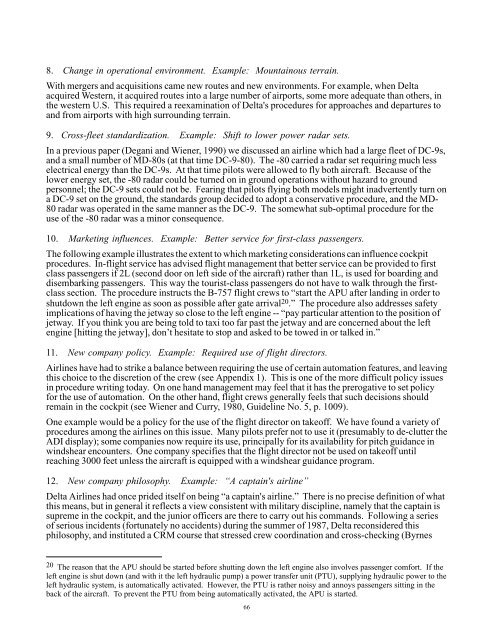On the Design of Flight-Deck Procedures - Intelligent Systems ...
On the Design of Flight-Deck Procedures - Intelligent Systems ...
On the Design of Flight-Deck Procedures - Intelligent Systems ...
You also want an ePaper? Increase the reach of your titles
YUMPU automatically turns print PDFs into web optimized ePapers that Google loves.
8. Change in operational environment. Example: Mountainous terrain.With mergers and acquisitions came new routes and new environments. For example, when Deltaacquired Western, it acquired routes into a large number <strong>of</strong> airports, some more adequate than o<strong>the</strong>rs, in<strong>the</strong> western U.S. This required a reexamination <strong>of</strong> Delta's procedures for approaches and departures toand from airports with high surrounding terrain.9. Cross-fleet standardization. Example: Shift to lower power radar sets.In a previous paper (Degani and Wiener, 1990) we discussed an airline which had a large fleet <strong>of</strong> DC-9s,and a small number <strong>of</strong> MD-80s (at that time DC-9-80). The -80 carried a radar set requiring much lesselectrical energy than <strong>the</strong> DC-9s. At that time pilots were allowed to fly both aircraft. Because <strong>of</strong> <strong>the</strong>lower energy set, <strong>the</strong> -80 radar could be turned on in ground operations without hazard to groundpersonnel; <strong>the</strong> DC-9 sets could not be. Fearing that pilots flying both models might inadvertently turn ona DC-9 set on <strong>the</strong> ground, <strong>the</strong> standards group decided to adopt a conservative procedure, and <strong>the</strong> MD-80 radar was operated in <strong>the</strong> same manner as <strong>the</strong> DC-9. The somewhat sub-optimal procedure for <strong>the</strong>use <strong>of</strong> <strong>the</strong> -80 radar was a minor consequence.10. Marketing influences. Example: Better service for first-class passengers.The following example illustrates <strong>the</strong> extent to which marketing considerations can influence cockpitprocedures. In-flight service has advised flight management that better service can be provided to firstclass passengers if 2L (second door on left side <strong>of</strong> <strong>the</strong> aircraft) ra<strong>the</strong>r than 1L, is used for boarding anddisembarking passengers. This way <strong>the</strong> tourist-class passengers do not have to walk through <strong>the</strong> firstclasssection. The procedure instructs <strong>the</strong> B-757 flight crews to “start <strong>the</strong> APU after landing in order toshutdown <strong>the</strong> left engine as soon as possible after gate arrival 20 .” The procedure also addresses safetyimplications <strong>of</strong> having <strong>the</strong> jetway so close to <strong>the</strong> left engine -- “pay particular attention to <strong>the</strong> position <strong>of</strong>jetway. If you think you are being told to taxi too far past <strong>the</strong> jetway and are concerned about <strong>the</strong> leftengine [hitting <strong>the</strong> jetway], don’t hesitate to stop and asked to be towed in or talked in.”11. New company policy. Example: Required use <strong>of</strong> flight directors.Airlines have had to strike a balance between requiring <strong>the</strong> use <strong>of</strong> certain automation features, and leavingthis choice to <strong>the</strong> discretion <strong>of</strong> <strong>the</strong> crew (see Appendix 1). This is one <strong>of</strong> <strong>the</strong> more difficult policy issuesin procedure writing today. <strong>On</strong> one hand management may feel that it has <strong>the</strong> prerogative to set policyfor <strong>the</strong> use <strong>of</strong> automation. <strong>On</strong> <strong>the</strong> o<strong>the</strong>r hand, flight crews generally feels that such decisions shouldremain in <strong>the</strong> cockpit (see Wiener and Curry, 1980, Guideline No. 5, p. 1009).<strong>On</strong>e example would be a policy for <strong>the</strong> use <strong>of</strong> <strong>the</strong> flight director on take<strong>of</strong>f. We have found a variety <strong>of</strong>procedures among <strong>the</strong> airlines on this issue. Many pilots prefer not to use it (presumably to de-clutter <strong>the</strong>ADI display); some companies now require its use, principally for its availability for pitch guidance inwindshear encounters. <strong>On</strong>e company specifies that <strong>the</strong> flight director not be used on take<strong>of</strong>f untilreaching 3000 feet unless <strong>the</strong> aircraft is equipped with a windshear guidance program.12. New company philosophy. Example: “A captain's airline”Delta Airlines had once prided itself on being “a captain's airline.” There is no precise definition <strong>of</strong> whatthis means, but in general it reflects a view consistent with military discipline, namely that <strong>the</strong> captain issupreme in <strong>the</strong> cockpit, and <strong>the</strong> junior <strong>of</strong>ficers are <strong>the</strong>re to carry out his commands. Following a series<strong>of</strong> serious incidents (fortunately no accidents) during <strong>the</strong> summer <strong>of</strong> 1987, Delta reconsidered thisphilosophy, and instituted a CRM course that stressed crew coordination and cross-checking (Byrnes20 The reason that <strong>the</strong> APU should be started before shutting down <strong>the</strong> left engine also involves passenger comfort. If <strong>the</strong>left engine is shut down (and with it <strong>the</strong> left hydraulic pump) a power transfer unit (PTU), supplying hydraulic power to <strong>the</strong>left hydraulic system, is automatically activated. However, <strong>the</strong> PTU is ra<strong>the</strong>r noisy and annoys passengers sitting in <strong>the</strong>back <strong>of</strong> <strong>the</strong> aircraft. To prevent <strong>the</strong> PTU from being automatically activated, <strong>the</strong> APU is started.66
















